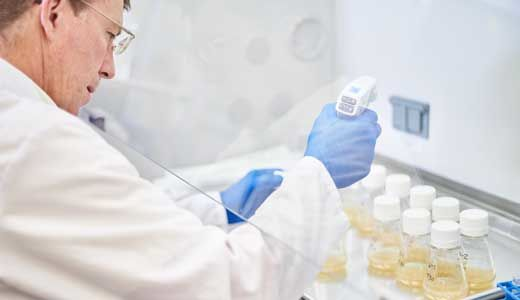Optimization is key to achieving a high-producing CHO cell culture. Identify the right combination of culture medium, feed supplements, and feeding strategy early in upstream process development to conserve precious time and resources.
Factors for high-performance fed-batch culture
Fed-batch culture is the most common way to manufacture recombinant therapeutic proteins in CHO cell cultures. Many variables can impact performance. Volumetric productivity and product titer are a function of viable cell density, specific productivity, and culture longevity. In turn, these functions are influenced by the medium and feed composition.
Efficient upstream process development (PD) requires optimized medium and feed formulations, as well as feeding strategy. To keep nutrient levels stable, the feed formulation must balance the cell line’s needs throughout the culture period. Studies show that culture media and feed compositions can influence cell growth, protein productivity, gene expression, product quality, and lactate and ammonia metabolism. Therefore, selecting a suitable culture medium and feed platform is essential for developing a fed-batch biomanufacturing process.
It is challenging to select a platform, because different CHO cell types and clones have different nutrient requirements. Each clone candidate requires screening, design, and optimization of media and feed formulations and feeding strategies. This generally requires considerable time, labor, materials, and cell culture know-how. Suboptimal CHO cell growth can slow down early PD in companies pressured to reach market quickly.
To help make early process development for fed-batch processes more efficient, several solutions are available. These include comprehensive selection guides, services, and screening based on design of experiments (DoE).

Find media and feeds with ease
For off-the-shelf media and feeds, consult our HyClone media and supplement selection guide. Rapidly identify media for a specific cell line and investigate the design space for developing optimized feed strategies.
Let us help – spent media analysis and medium development services
Our in-house process developers can work with clients to develop media tailored to their cell line or clone. We can also measure nutrients depleted in the spent media, plus other metabolites. These measurements are correlated to features, such as culture vitality, peak viable cell density, and culture longevity to optimize feed strategy.
Use DoE for PD – high-throughput workflow makes it quick
A design of experiment approach can screen a wide range of medium and feed combinations to save time and resources. A high-throughput workflow allows exploration of the design space in parallel experiments, while keeping materials consumption low.
We have designed and implemented a rapid 2-step DoE protocol with a MODDE™ statistical software. This tool can help to determine the best feeds, then optimize their concentration and timing for addition. Optimization is simplified, and less time is spent on screening to find a medium and feed combination that works well for a particular CHO cell line.
We implemented this protocol for a mAb-producing CHO cell line. In step 1, the best performing feed supplements were selected (30 mL scale). In step 2, their ratios were optimized according to culture requirements. The optimized feed formulation was then verified in a 500 mL bioreactor run.
Result: high yield and quality
Using the 2-step DoE protocol, a fed-batch process was developed that increased antibody concentrations from 1.9 g/L (unspiked) to 4.9 g/L. This process simplified optimization and increased yield. We found that product glycosylation and charge variants could be influenced by the newly selected basal media and feeds compared with a legacy fed-batch process. The amount of aggregated product was not altered.
This workflow can be used with other cell culture medium and feed systems for rapid process development and optimization, ultimately reducing time to market.
Learn more about this design of experiments approach
Read the full case study on using DoE to optimize fed-batch culture
Download the DoE protocol to use in the lab